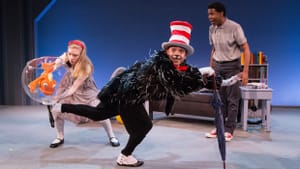Stay in the Loop
BSR publishes on a weekly schedule, with an email newsletter every Wednesday and Thursday morning. There’s no paywall, and subscribing is always free.
Dr. Seuss would have loved this
Arden Theatre’s ‘The Cat in the Hat’

Theodor Geisel (1904-1991), better known as Dr. Seuss, belonged to a small but influential group of mid-20th century radicals who believed that education ought to be fun. That group included Munro Leaf (1905-1976), the author/illustrator of whimsical children’s books like How to Behave and Why, Brushing Your Teeth Can Be Fun, and his 1936 classic, The Story of Ferdinand, about a bull who’d rather sniff flowers than fight (it was banned by Hitler and Franco for its implied pacifist message, but Gandhi loved it).
Geisel’s comrades in arms also included the outwardly Victorian couple who ran the international summer camp in the French Alps that I attended in the early ’50s. Donald MacJannet (1894-1986) and his German-born wife Charlotte (1901-1999) believed education could be not only fun but downright exciting if kids were exposed to four elements: a secure and welcoming environment, a spectacular location where kids could “learn by doing,” a culture different from their own, and teachers who listened to them instead of lectured them.
We MacJannet campers didn’t understand this theory at the time, of course. As one of my campmates observed decades later, the MacJannets disguised their program as a “camp,” but “education there was continuous from morning to night.”
Anarchistic message
Dr. Seuss similarly sought to find ways to get kids excited about reading. On the surface, The Cat in the Hat (1957) seems little more than a frivolous piece of mischievous nonsense: A brother and sister, alone in their home and bored silly on a rainy afternoon, suddenly find their living room invaded by a human-sized cat and his two incorrigible assistants (Thing One and Thing Two), who coax the kids into breaking every household rule that their mother has so carefully taught them. But The Cat in the Hat is more than a paean to imagination as an antidote to boredom: When the Cat announces, “I know it is wet and the sun is not sunny/But we can have lots of good fun that is funny!” he is demonstrating to new readers the joy of forming letters into words — especially the sort of one-syllable words most favored by early readers — and stringing them together.
Goldfish as flutist
The Arden Children’s Theatre’s recent stage adaptation, originally produced by the National Theatre of Great Britain, takes Dr. Seuss’s innovation a step further: Here actions — specifically, pantomime and acrobatics — speak louder than words. Many minutes pass in this show before anyone says anything. The siblings (Richard Crandle and Maggie Johnson) express their boredom through delightful silent mimicry, enabling the kids in the audience to figure out what’s going on without adult guidance. Once the Cat (Doug Hara, very reminiscent of Charlie Chaplin) waltzes in, inanimate objects spring to life: A tennis racquet becomes a guitar and then a banjo, a sofa cushion metamorphosizes into an accordion, and the goldfish reveals himself as an accomplished flutist. The Cat, meanwhile, stands atop a giant rotating ball while balancing a chocolate cake and a teacup on his hat. (At least it seemed that way. During the talkback afterward, I learned that it’s mostly done with magnets.)
The Arden enjoys a well-deserved reputation for productions that teach kids by entertaining them. My only regret about this particular show is that the good doctor wasn’t around to observe what his words and pictures have led to — that, and that I didn’t see The Cat and the Hat sooner so I could spread the word about its virtues. (Its two-month run ends Sunday, June 29.)
What, When, Where
The Cat in the Hat. Adapted from the Dr. Seuss book by Katie Mitchell; Doug Hara and Steve Pacek directed. Arden Children’s Theatre production through June 29, 2014 at Arden’s Arcadia Stage, 40 N. Second St., Philadelphia. 215-922-1122 or www.ardentheatre.org.
Sign up for our newsletter
All of the week's new articles, all in one place. Sign up for the free weekly BSR newsletters, and don't miss a conversation.

 Dan Rottenberg
Dan Rottenberg